|

a
woman's
life
births
weddings
divorces
death
& dying
manners
cooking
housework
shopping
gardening
livestock &
poultry care
education
employment
opportunities
recreation
& hobbies
holidays
&
feast days
board
games
music
embroidery
& needlework
pet
keeping
reading
dancing
horseriding
hawking
hunting
sex &
sexual health
PLEASE NOTE!
ADULT THEMES!
|

The
Very, Secret Sex Lives of Medieval Women
Sex, Sexual Health, Contraception and Sexuality
CHURCH PROHIBITIONS - SEXUAL HEALTH - APHRODISIACS
- PROCREATION
CONTRACEPTIVES & ABORTIVES - PROSTITUTE- THE CULT OF THE VIRGIN
- - ADULT THEMES - -
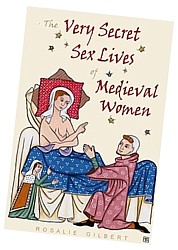 The
Very Secret Sex Lives of Medieval Women is now a book! You
can find information about it in the BOOK
tab at the top of the page. This page contains a very small overview
of some of the key elements in a medieval woman's private life. The
Very Secret Sex Lives of Medieval Women is now a book! You
can find information about it in the BOOK
tab at the top of the page. This page contains a very small overview
of some of the key elements in a medieval woman's private life.
Unlike today, a woman's status
in society wasn't gauged by her age or profession, but by her
sexual status.
She was either (ideally) a virgin, a wife or a widow. Her rights
and obligations were dependent on these. Holy women, who may have
at one time been wives or widows and may no longer have been actual
virgins, were considered virgins as brides of Christ and usually
fell into the same category as unmarried, and therefore chaste,
women. An unmarried woman who was not a virgin, either because
she was a mistress or prostitute found herself on tenuous ground
both legally and in society.

Church
prohibitions
On the subject of sex, the church had much to say.
Not only did it have differing
opinions of the goodness women in general, it also recognised
the need for men to marry and produce heirs.  Obviously,
all women were sinful descentants of Eve from the Garden of Eden,
who was not loved much by the church. This feeling was echoed
from the pulpit by men who weren't very keen on women as a gender.
The 11th century cardinal Peter Damien wrote that; Obviously,
all women were sinful descentants of Eve from the Garden of Eden,
who was not loved much by the church. This feeling was echoed
from the pulpit by men who weren't very keen on women as a gender.
The 11th century cardinal Peter Damien wrote that;
...woman is Satan's
bait.. poison for men's souls..
The church acknowledged that
a woman was required as part of God's play to go forth and multiply.
A woman shouldn't, however, enjoy sexual relations. It
was something to be endured for the sake of procreation.
Since sex couldn't be forbidden entirely, restrictions on when
relations could take place were in place. Listed below are some
of the times when it was not permissible to have sex, even with
one's own husband.
Sex was not permitted on a Wednesday, or a Friday, on a Sunday,
or Saturday, on any of the 60 church feast days, during lent,
during Advent, during Whitsun week, Easter week, while a woman
is menstruating, while a woman is pregnant, while a woman is breastfeeding,
within the walls of a church, during daylight, if she is completely
naked, for the eight days leading up her husband taking the Eucharist
or if the couple was related, even by marriage. The only permissible
position was the missionary position.
The church confessional became increasingly personal. Priests
could ask the most personal questions about a woman's most private
practices. Among the questions listed in an 11th century Confessors
Manual, are questions specifically aimed at women-
Have you made a
tool or device in the shape of a penis and tied it to your
private parts and fornicated with other women with it? Have
you swallowed semen to enhance your husbands desire?
The fact that the church
felt the need to even ask this question tells us a certain amount
about sex practices which were frowned upon, even if they didn't
involve sex with men.

Sexual
health
It was believed that sex was a requirement for a woman's ongoing
good health. A husband's impotency was taken quite seriously,
as it was believed that a woman needed regular sexual intercourse
for her emotional and physical well-being.
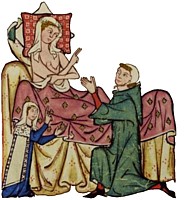 The
humors which would build up inside her if she was denied her could
lead to madness, convulsions, fainting fits, suffocation of the
womb and hysteria. A woman could divorce a man for his inability
to perform. The
humors which would build up inside her if she was denied her could
lead to madness, convulsions, fainting fits, suffocation of the
womb and hysteria. A woman could divorce a man for his inability
to perform.
Thomas of Chobham devised
a method to determine if a husband was was absolutely impotent.
He approved a physical examination of the man's genitals by 'wise
matrons', followed by a bedroom trial:
'after food and drink,
the man and the woman are to be placed together in one bed and
wise women are to be summoned around the bed for many nights.
And if the man's member is found to be useless and as if dead,
the couple are well to be separated.
There are documented court
cases in both 1292 at Canterbury and 1433 in York where wise women
testified against the husband in cases such as this. It was not
unusual that the wise matrons were family members or known to
the man. This could hardly improve performance issues he may have
been having.

Aphrodisiacs
Trying to encourage a potential lover or husband is a thing we
do even today. We associate certain foods and herbs with being
sexy or promoting desire. Medieval aphrodisiacs were not of the
ilk that we hope for today. Today we think champagne, caviar and
oysters. Or chocolate. The medieval woman was unlikely to find
any of these on her list of things to inflame the passions, so
what might she consider? Onions. Let's start with onions. 
The Four Seasons of the House of Cerruti, which is a copy of the
Tacuinum Sanitatis from the 14th century Vienna has this
to say:
An excellent thing,
the onion, and highly suited for old people. They generate
milk in nursing mothers and fertile semen in men.
A different translation of
the same manuscript, the Tacuinum sanitatus, Paris, folio
24v, has this to add:
Onion. (Cepe)
Nature: (according to Rasis) warm in the fourth degree, moist
in the third.
Optimum: The white ones which are watery and juicy.
Usefulness: They are diuretic and fecilitate coitus.
Dangers: They cause headaches.
Neutralisation of the dangers: With vinegar and milk.
One might think that onion
breath might be somewhat off-putting, but the manuscript fails
to tell us how to prepare them for the desired effect. It also
causes a confusing conundrum. It increases the desire but at the
same time gives a headache.
Hildegarde von Bingen recommended steering away from them altogether
and wasn't a fan at all.
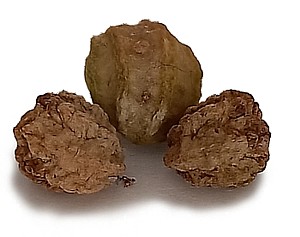 Garden
Nasturtiums are also recommended. If you look closely at the seeds,
you might feel that they look quite similar to a certain male
genitalia, and you'd be right. Garden
Nasturtiums are also recommended. If you look closely at the seeds,
you might feel that they look quite similar to a certain male
genitalia, and you'd be right.
Attributing properties to foods and plants in the natural world
based on things it reminded one of, was called the Doctrine
of Signatures. It was understood that since God had created
all things, both good and ill, health and disease, then he had
put the cures for all ills here on earth with us, we only needed
to find them.
We would find them, it was thought, by seeing similarities in
the physical object and what it was needed to cure.
If a bean looked like a kidney, it stood to reason that it would
be helpful medicinally for the kidney. So, in this way, nasturtium
seeds, which resembles testicles, would be helpful to augment
the sperm and coitus. Several
versions of the Tacuinum
sanitatus include
the uses: Augment the sperm and coitus but cause migraines (Vienna,
f 30v) and Augments
the sperm and coitus but also causes migraines (Casanatense,
f.LIV.)
 Asparagus
should also be helpful to increase desire. The Four Seasons
of the House of Cerruti assures us it absolutely was. It tells
us: Asparagus
should also be helpful to increase desire. The Four Seasons
of the House of Cerruti assures us it absolutely was. It tells
us:
Pick those young stalks
whose tips point downwards. They open up occlusions which
prevent the humours from flowing regularly through the body's
passages, and they stimulate carnal relations. Asparagus is
harmful to the intestinal hairs unless it is first boiled
in salted water with vinegar.
The fact that it is male
member-shaped isn't worth thinking about. Another version of the
same manuscript from Vienna, tells us that it influences coitus
positively, but doesn't say for which gender.
A medieval woman who wants something a little more all-purpose
could turn to leeks. They stimulate urination, influence coitus
and, when mixed with honey, clear up catarrh of the chest, according
to that quite-reliable source of herbal healthcare, the Tacuinum
Sanitatis. Rather unhelpfully, it doesn't clarify whether
the coitus is influenced for the better or worse.

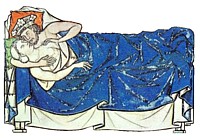 Sex
for procreation Sex
for procreation
Producing an heir was serious business for the medieval family
and a woman was expected to provide a male heir to keep the family
name, business and land holdings. A marriage was often not deemed
proper until coitus had taken place, sometimes with witnesses.
The image detail at left comes from a 13th century manuscript
the Maciejowski Bible, from France. It shows a king in
bed with a woman who has her hair sensibly arranged in a coif.
Medieval manuscripts offered advice to lift a libido or assist
if pregnancy was desired. The Tacuinim Sanitatus, from
Vienna, also known as The Four Seasons of the House of Cerruti,
offers this herbal advice:
Sage: It is good for
the stomach and cold diseases of the nerves. It's digestion
is slow but can be speeded up with honey. We read that if a
woman who has slept alone for four days drinks this and then
has sexual relations, she will immediantly become pregnant.
To this end, women who survived the plague in one town in Egypt
were made to drink the juice of sage leaves so the town could
quickly be repopulated.
There was other advice on
the best times for sex to produce male heirs and there were many
recipes to guarantee a pregnancy. Herbal books such as the Tacuinum
Sanitatus from the 14th century offered herbal remedies almost
certainly guaranteed the gender of choice, as did Trotula, who
is reknowned for her weasel testicle recipes.

Contraceptives
and abortives
Rather surprisingly, medieval women did know about and use contraception.
Since childbirth was so perilous, many women desired contraception
which was roundly condemned by the church. St Augustine declared
that any woman, whether she was married or otherwise, became a
whore in the eyes of God if she used contraceptives, as the only
reason for sexual intercourse was procreation.
Abortion was also frowned upon as it was stated in the dictum
that a fetus had a soul of its own after 40 days. In both civil
and canon law in 13th century England, abortion was condoned in
certain conditions only- in the case of an unborn child endangering
the life of the mother, it was the life of the mother who was
to be saved. Debates on contraception for a woman who had previous
complications with pregnancy were held with great seriousness.
Should a woman refrain from sex so that she might not conceive
and possibly die in childbirth? What about her martial obligations?
Were contraceptives permissible in situations such as these?
Luckily, breastfeeding and
poor nutrition provided a certain amount of contraceptive measure
for peasant woman. Women in higher society were more likely to
have wet nurses and better diets and thereby ran the risk of pregnancy
sooner than her poorer counterpart.
One contraceptive measure
recorded by medieval German women is using beeswax and rags to
form a physical block. Other popular herbal compounds used rosemary
and balsam with or without palsley (parsley?)
 Trotula
offered many helpful herbal remedies, and a few rather strange
ones. Her most famous is the one with the weasels: Trotula
offered many helpful herbal remedies, and a few rather strange
ones. Her most famous is the one with the weasels:
Take a male weasel and
let its testicles be removed and let it be released alive. Let
the woman carry these testicles with her in her bosom and let
her tie them in goose skin or in another skin, and she will
not conceive
A future Pope wrote about
contraceptives for men in his book The Treasure of the Poor.
A plaster made of hemlock, pictured at right, applied to the testicles
of the husband prior to the sexual act was recommended as a male
contraceptive.

Medieval
prostitutes
Women who made their living in the sex industry were as active
in the middle ages as they are today. Prostitutes were generally
looked down upon but deemed to be a necessary evil- something
that society needed but would rather not talk about.
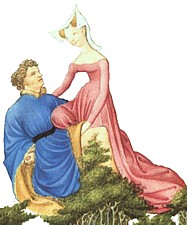 Shown
at right is a detail from the 1400-1409 painting Paul The Hermit
Sees A Christian Tempted. Shown
at right is a detail from the 1400-1409 painting Paul The Hermit
Sees A Christian Tempted.
At times women who were prostitutes wore visible markers on their
clothing to identify them with their trade. Ironically,
at certain periods over the Middle Ages, prostitutes were exempted
from sumptuary laws because it was acknowledged that a women in
that line of work required certain things to make her desirable
in order to make a living.
Dress in the Middle Ages by Francoise Piponnier and Perrine
Maine state that:
The striped cloak
.. in Marseilles.. the striped hood worn in England, the white
hood of Talouse, the black and white pointed hat of Strasbourg
were increasingly replaced by bands of fabric stitched to
the sleeve or the shoulder, then by tassels worn on the arm.
The church, although scathing
in their condemnation of sex and women who have it generally,
were not above being involved in the industry. A brothel in Dijon,
France, lists twenty per cent of its clients as churchmen.
It's also recorded that the Bishop of Winchester received regular
rent from the brothels of Suffolk.
Guidelines were needed to regulate the hours and wages of prostitutes
so that the women might not be taken advantage of. In that way,
the industry was regulated with fixes wages and working hours.
There were always women who worked outside these, though, and
these were the women forced into prostitution against their will
by mothers, family, ladylords or brothel owners who were disreputable.

The
Cult of the Virgin
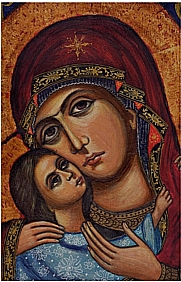 Many
clergy despised woman as instigators of original sin and for their
general weakness although there was the issue of the Virgin Mary
who really made things tricky. Mary was a woman, and Christ's
mother, and therefore the holiest and purest of all women, and
as an example of womanhood, could not be faulted. Many
clergy despised woman as instigators of original sin and for their
general weakness although there was the issue of the Virgin Mary
who really made things tricky. Mary was a woman, and Christ's
mother, and therefore the holiest and purest of all women, and
as an example of womanhood, could not be faulted.
Many female saints were also virgins, and the church could not
deny their holiness. This caused a catch 22 situation, where women
were to be loathed and reviled, but also revered and worshiped.
While sex was regarded and somewhat necessary for procreation,
many women chose to live a life of celibacy and religious devotion.
This was often seen by family as a blessing.
Prayers from a nun were believed to be more powerful than prayers
from a lay woman. A dowry was not required for a marriage that
would never happen and it many cases, it was the only way for
a girl to obtain a really good education.
In many instances, the choice for a woman to remain a virgin,
even after marriage was not enthusiastically greeted by the family
or spouse. A woman who remained chaste, although admired for her
purity and devotion to God, was certainly putting her health at
risk by not gaining enough male seed or by the poisonous humours
which were not being released.

Copyright
© Rosalie Gilbert
All text & photographs within this site are the property of
Rosalie Gilbert unless stated.
Art & artifact images remain the property of the owner.
Images and text may not be copied and used without permission.
|